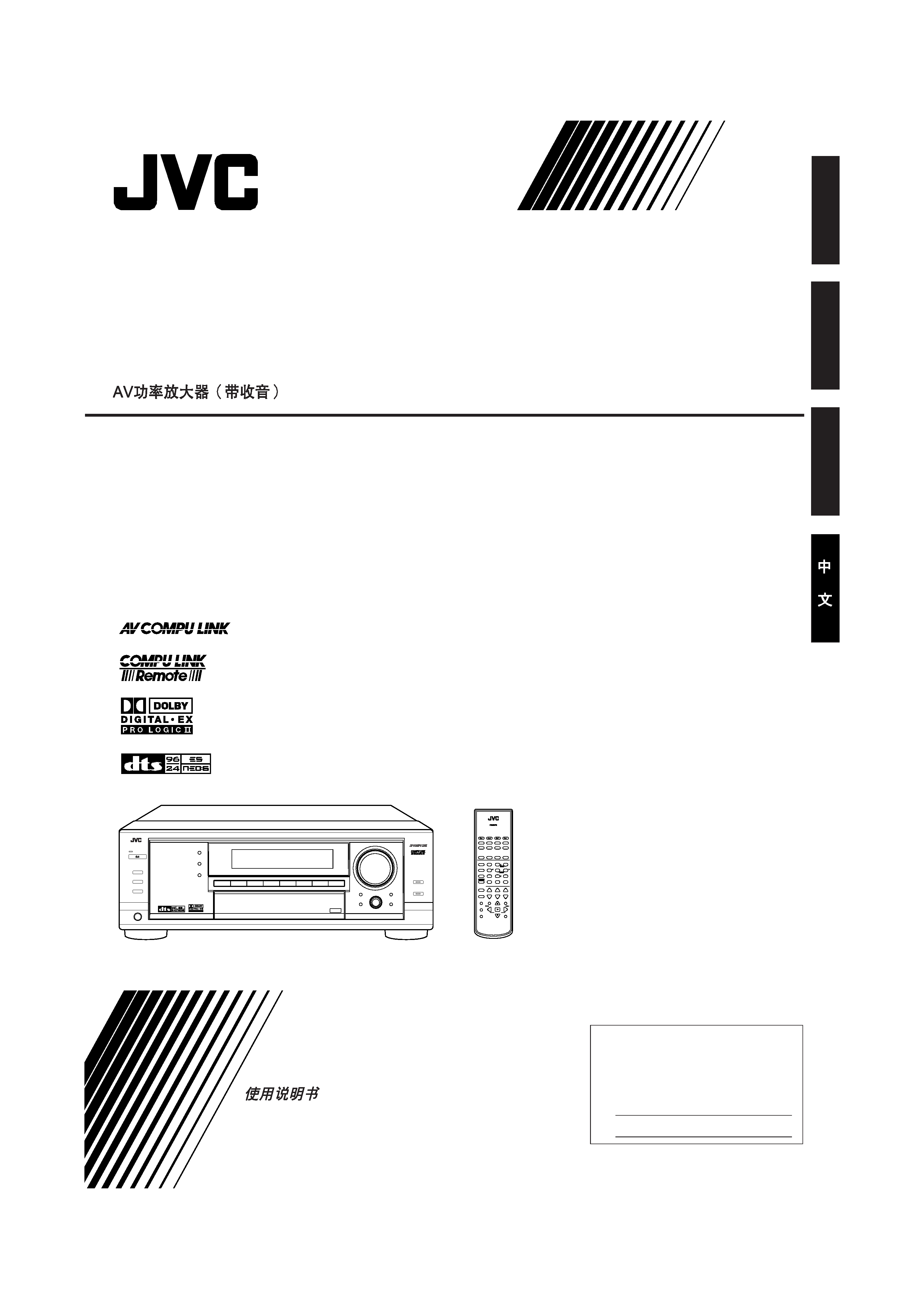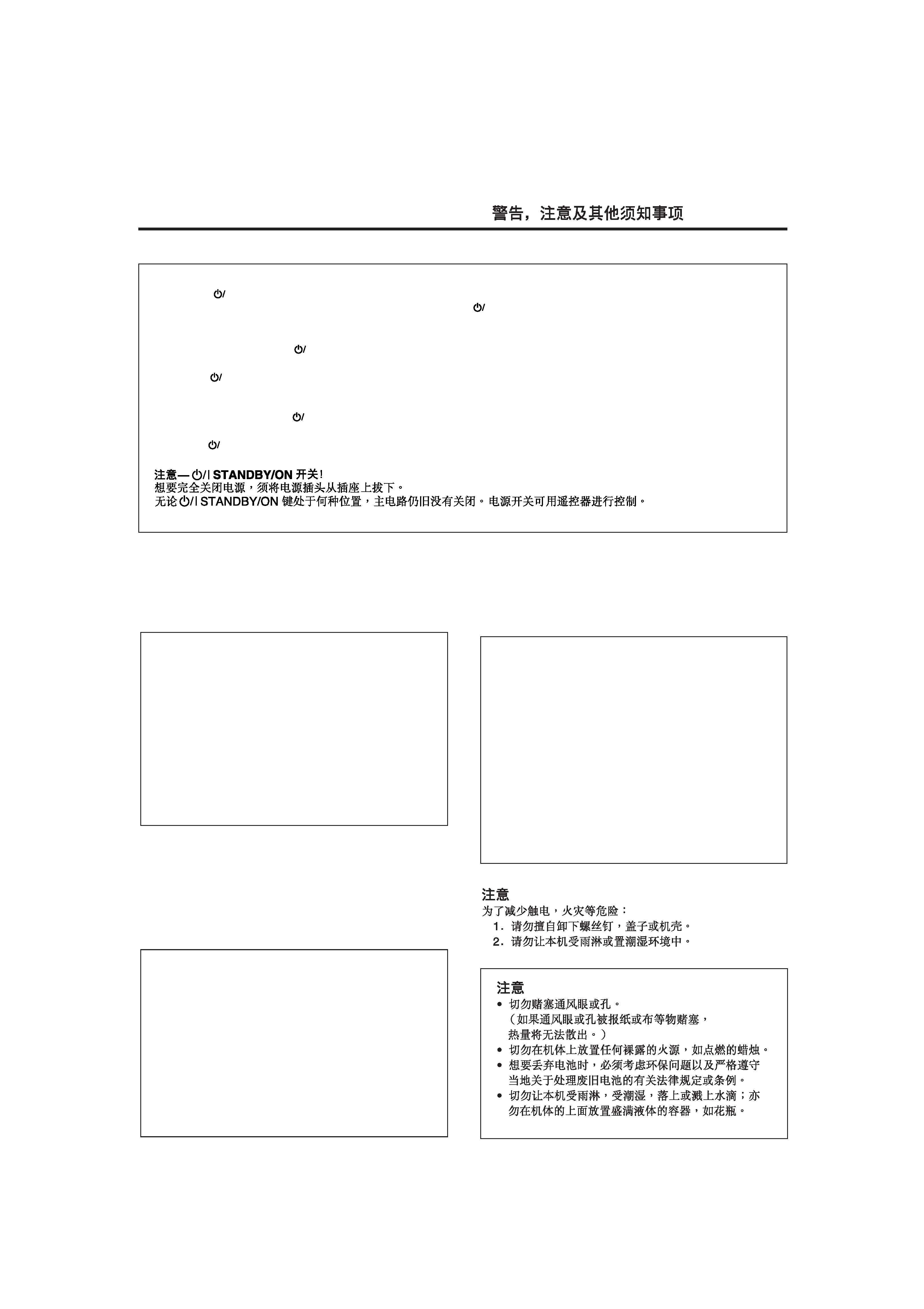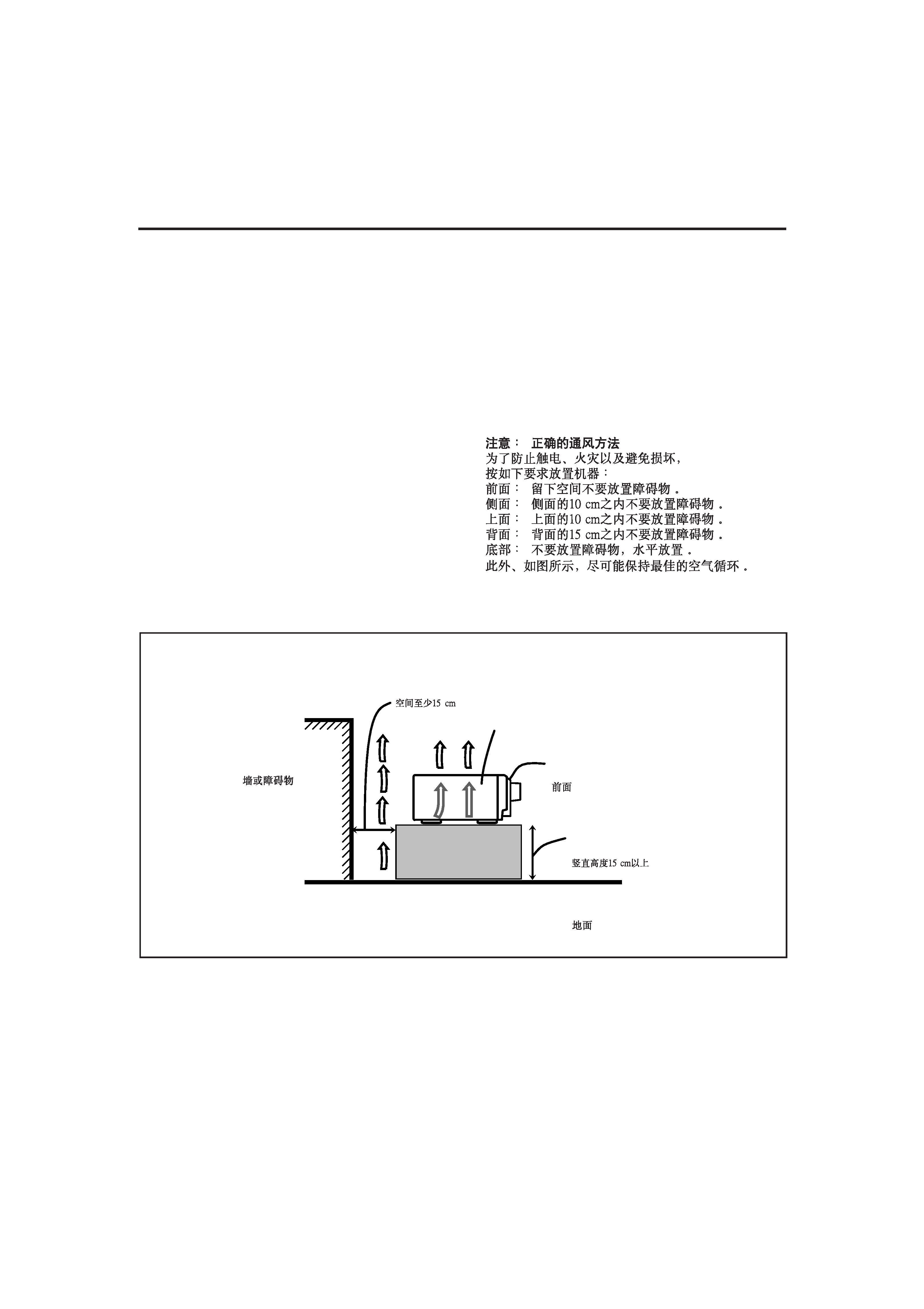
For Customer Use:
Enter below the Model No. and Serial
No. which are located either on the rear,
bottom or side of the cabinet. Retain this
information for future reference.
Model No.
Serial No.
LVT1007-005A[US]
RX-7032VSL
AUDIO/VIDEO CONTROL RECEIVER
RECEPTOR DE CONTROL DE AUDIO/VÍDEO
RECEPTOR DE COMANDO AUDIO/VÍDEO
MASTER VOLUME
PUSH OPEN
SUBWOOFER OUT ON/OFF
SPEAKERS ON/OFF
PHONES
1
STANDBY
RX-7032V
AUDIO/VIDEO CONTROL RECEIVER
BASS BOOST
ANALOG DIRECT
2
STANDBY/ON
TV SOUND/DBS
VCR
DVD
DVD MULTI
AM
FM
TAPE/CDR
CD
SETTING
ADJUST
QUICK SPEAKER
SETUP
EXIT
SURROUND
DSP
SURROUND/ DSP
OFF
INSTRUCTIONS
MANUAL DE INSTRUCCIONES
INSTRUÇÕES
+
-
+
-
+
-
23
1
56
4
89
7/P
0
+10
FRONT¥L
MENU
ENTER
FRONT¥R
TEST
CDDISC
MIDNIGHT
CENTERSUBWOOFER
DIGITALEQ SURR BACK
SURR¥L SURR¥R
SOUND
CH/
LEVEL TVVOL
/REW
DOWN
TUNING
UP
FF/
MUTING
DIMMER
VOLUME
CATV/DBS
CONTROL
TAPE/CDR
CONTROL
VCR
CONTROL
TV/VIDEO
REC PAUSE
SLEEP
RETURN
FMMODE
100+
REMOTE CONTROL
RM-SRX7032U
CATV/DBS
VCR
TV
AUDIO
DSP
OFF
DVD MULTI
CD
ANALOG/DIGITAL
BASS BOOST
TAPE/CDR
FM/AM
TV/DBS
VCR
SURROUND
EX/ES
SURR/DSP
A/V CONTROL RECEIVER
INPUT
MODE
DIRECT
ANALOG
DVD
10/0
English
Espa
ñ
ol
Portugu
ê
s
COVER_7032[US]f.pm6
03.3.13, 4:35 PM
1

G-1
Caution
STANDBY/ON switch!
Disconnect the mains plug to shut the power off completely. The
STANDBY/ON switch in any position does not disconnect
the mains line. The power can be remote controlled.
Precaución Interruptor
STANDBY/ON!
Desconectar el cable de alimentación para desactivar la alimentación totalmente. Cualquier que sea la posición de ajuste del
interruptor
STANDBY/ON, la alimentación no es cortada completamente.
La alimentación puede ser controlada
remotamente.
Precaução Interruptor
STANDBY/ON!
Desconectar o cabo de alimentação para desligar a alimentação por completo. Qualquer que seja a posição de ajuste do
interruptor
STANDBY/ON, a alimentação não é completamente cortada. A alimentação pode ser controlada remotamente.
Warnings, Cautions and Others / Avisos, precauciones y otras notas /
Advertêcias, precauções e outras notas /
CAUTION
·
Do not block the ventilation openings or holes.
(If the ventilation openings or holes are blocked by a
newspaper or cloth, etc., the heat may not be able to get
out.)
·
Do not place any naked flame sources, such as lighted
candles, on the apparatus.
·
When discarding batteries, environmental problems must be
considered and local rules or laws governing the disposal of
these batteries must be followed strictly.
·
Do not expose this apparatus to rain, moisture, dripping
or splashing and that no objects filled with liquids, such
as vases, shall be placed on the apparatus.
AVISO
·
Não obstrua as aberturas e orifícios de ventilação. (Se
os orifícios ou aberturas de ventilação estiverem
obstruídos por qualquer papel ou tecido, não haverá
circulação do ar quente.)
·
Não coloque nenhum objeto com chamas, como velas
acesas, sobre o aparelho.
·
Ao descartar as baterias, leve em consideração os
problemas que possam ser causados ao meio ambiente
e os regulamentos e leis locais e governamentais sobre
recolhimento dessas baterias devem ser rigorosamente
seguidos.
·
Não exponha este aparelho à chuva, umidade, pingos
ou esguichos de água, nem coloque em cima do
mesmo qualquer tipo de recipiente que contenha
líquidos, como por exemplo vasos.
CAUTION
To reduce the risk of electrical shocks, fire, etc.:
1.
Do not remove screws, covers or cabinet.
2.
Do not expose this appliance to rain or moisture.
ATENÇÃO
Para reduzir riscos de choques eléctricos, incêndio, etc.:
1.
Não retire parafusos nem desmonte as tampas ou o gabinete.
2.
Não exponha este aparelho à chuva nem à umidade.
PRECAUCION
·
No obstruya las rendijas o los orificios de ventilación.
(Si las rendijas o los orificios de ventilación quedan tapados con
un periódico, un trozo de tela, etc., no se podrá disipar el calor).
·
No ponga sobre el aparato ninguna llama al descubierto, como
velas encendidas.
·
Cuando tenga que descartar las pilas, tenga en cuenta los
problemas ambientales y observe estrictamente los regla-
mentos o las leyes locales sobre disposición de las pilas.
·
No exponga este aparato a la lluvia, humedad, goteos o
salpicaduras. Tampoco ponga recipientes conteniendo
líquidos, como floreros, encima del aparato.
PRECAUCIÓN
Para reducir riesgos de choques eléctricos, incendio, etc.:
1.
No extraiga los tornillos, los cubiertas ni la caja.
2.
No exponga este aparato a la lluvia o a la humedad.
Safety_7032[US]f.pm6
03.3.13, 4:31 PM
1

G-2
Caution: Proper Ventilation
To avoid risk of electric shock and fire and to protect from damage.
Locate the apparatus as follows:
Front:
No obstructions open spacing.
Sides:
No obstructions in 10 cm from the sides.
Top:
No obstructions in 10 cm from the top.
Back:
No obstructions in 15 cm from the back.
Bottom:
No obstructions, place on the level surface.
In addition, maintain the best possible air circulation as illustrated.
Precaução: ventilação apropriada
Para prevenir o risco de choque elétrico ou incêndio e para proteger o
aparelho contra danos.
Localize-o da seguinte maneira:
Frente:
Espaço aberto, sem obstruções
Lados:
Espaço de 10 cm sem obstruções nos lados
Topo:
Espaço de 10 cm sem obstruções acima
Atrás:
Espaço de 15 cm sem obstruções atrás
Parte inferior:
Sem obstruções. Coloque o aparelho em superfície
nivelada.
Mantenha, além disso, a maior circulação de ar possível, como indica
a ilustração.
Wall or obstructions
Pared u obstrucciones
Parede ou obstáculo
Front
Frente
Frente
Stand height 15 cm or more
Allura del soporte 15 cm o más
Base com altura de 15 cm ou mais
RX-7032VSL
Spacing 15 cm or more
Espacio de 15 cm o más
Espaço de 15 cm ou mais
Floor
Piso
Piso
Precaución: Ventilación Adecuada
Para evitar el riesgo de choque eléctrico e incendio y para proteger el
aparato contra daños.
Ubique el aparato de la siguiente manera:
Frente:
Espacio abierto sin obstrucciones
Lados:
10 cm sin obstrucciones a los lados
Parte superior: 10 cm sin obstrucciones en la parte superior
Parte trasera:
15 cm sin obstrucciones en la parte trasera
Fondo:
Sin obstrucciones, colóquelo sobre una superficie
nivelada
Además, mantenga la mejor circulación de aire posible como se
ilustra.
Safety_7032[US]f.pm6
03.3.13, 4:31 PM
2

1
English
Introduction
We would like to thank you for purchasing one of our JVC products.
Before operating this unit, read this manual carefully and thoroughly to obtain the best possible performance
from your unit, and retain this manual for future reference.
Precautions
Power sources
· When unplugging the receiver from the wall outlet, always pull
the plug, not the AC power cord.
· Do not handle the AC power cord with wet hands.
· If you are not going to operate the receiver for an extended period
of time, unplug the AC power cord from the wall outlet.
Ventilation
High power amplifiers built in this receiver will generate heat inside
the cabinet. For safety, observe the following carefully.
· Make sure there is good ventilation around the receiver. Poor
ventilation could overheat and damage the receiver.
· Do not block the ventilation openings or holes. (If the ventilation
openings or holes are blocked by a newspaper or cloth, etc., the
heat may not be able to get out.)
Others
· Should any metallic object or liquid fall onto the unit, unplug the
unit and consult your dealer before operating any further.
· Do not expose this apparatus to rain, moisture, dripping or
splashing and that no objects filled with liquids, such as vases
shall be placed on the apparatus.
· Do not disassemble the unit since there are no user serviceable
parts inside.
If anything goes wrong, unplug the AC power cord and consult your
JVC dealer.
Features
Compatible with various audio formats including
DTS 96/24
RX-7032VSL allows you to enjoy a newly introduced audio
format such as Dolby Digital EX, Dolby Pro Logic II, DTS-ES,
DTS Neo:6, and DTS 96/24.
· This unit is also compatible with Dual Mono signals recorded in
Dolby Digital and DTS discs.
DAP (Digital Acoustic Processor)
Sound field simulation technology allows precise ambience
recreation of existing theaters and halls. Thanks to the high-
performance DSP (Digital Signal Processor) and high-capacity
memory, you can enjoy multi-channel surround sound by playing
2-channel or multi-channel software according to the speaker
setting.
Multi-channel headphone virtual surround
sound--3D HEADPHONE Mode
The built-in headphone virtual surround system is compatible with
Multi-channel software like Dolby Digital, DTS Surround, etc.
Thanks to the new signal processing algorithms used by the high-
performance DSP, you can enjoy a natural surround sound through
the headphones.
COMPU LINK remote control system
The COMPU LINK remote control system allows you to operate
other JVC audio/video components from this receiver.
01-14_7032[US]f.pm6
03.3.13, 4:31 PM
1

2
English
Table of Contents
Basic Settings ........................................... 23
Setting the Speakers Configuration .......................................... 23
Basic Setting Items ................................................................... 24
Basic Procedure ........................................................................ 25
Setting the Speakers ........................................................... 25
Setting the Speaker Distance ............................................. 26
Setting the Bass Sounds ..................................................... 27
Selecting main or sub channel--DUAL MONO ............... 27
Setting the Digital Input Terminals .................................... 28
Setting the Component Video Input ................................... 28
Memorizing the Volume Level for Each Source ................ 28
Adjusting Sound ........................................ 29
Basic Setting Items ................................................................... 29
Basic Procedure ........................................................................ 29
Adjusting the Equalization Patterns ................................... 30
Adjusting the Speaker Output Levels ................................ 30
Adjusting the Sound Parameters for the
Surround and DSP modes ............................................ 31
Using the Surround Modes .......................... 32
Reproducing Theater Ambience ................................................ 32
Introducing the Surround Modes ............................................. 32
Surround Modes Applicable to the Various Software .............. 34
Activating the Surround Modes ............................................... 35
7 Activating the EX/ES setting ................................................ 35
7 Activating the Surround Modes ............................................ 35
Using the DSP Modes ................................ 36
Reproducing the Sound Field ................................................... 36
Introducing the DSP Modes ..................................................... 36
Activating the DSP Modes ....................................................... 37
Using the DVD MULTI Playback Mode .......... 38
Activating the DVD MULTI Playback Mode .......................... 38
COMPU LINK Remote Control System ......... 39
AV COMPU LINK Remote Control System .... 40
Operating JVC's Audio/Video Components ... 42
Operating Audio Components .................................................. 42
Operating Video Components .................................................. 44
Operating Other Manufacturers' Video
Equipment ............................................ 45
Troubleshooting ......................................... 49
Specifications ............................................ 50
Parts Identification ...................................... 3
Remote Control .......................................................................... 3
Front Panel ................................................................................. 4
Rear Panel .................................................................................. 6
Getting Started ........................................... 7
Before Installation ...................................................................... 7
Checking the Supplied Accessories ........................................... 7
Adjusting the Voltage Selector ................................................... 7
Putting Batteries in the Remote Control .................................... 7
Connecting the FM and AM Antennas ....................................... 8
Connecting the Speakers ............................................................ 9
Connecting Audio/Video Components ..................................... 11
7 Analog Connections ............................................................. 11
7 Digital Connections .............................................................. 14
Connecting the Power Cord ..................................................... 14
Basic Operations ....................................... 15
Daily Operational Procedure .................................................... 15
Turning On the Power .............................................................. 15
Selecting the Source to Play ..................................................... 15
Adjusting the Volume ............................................................... 16
Selecting the Front Speakers .................................................... 17
Activating and Adjusting the Subwoofer Sound ...................... 17
Selecting the Analog or Digital Input Mode ............................ 17
Setting the Dynamic Range ...................................................... 18
Attenuating the Input Signal .................................................... 18
Turning Analog Direct On and Off .......................................... 19
Changing the Source Name ...................................................... 19
Reinforcing the Bass ................................................................ 20
Muting the Sound ..................................................................... 20
Changing the Display Brightness ............................................. 20
Using the Sleep Timer .............................................................. 20
Receiving Radio Broadcasts ........................ 21
Setting the AM Tuner Interval Spacing .................................... 21
Tuning in to Stations Manually ................................................ 21
Using Preset Tuning ................................................................. 21
Selecting the FM Reception Mode ........................................... 22
This mark indicates that ONLY the remote control
CAN be used for the operation explained.
Remote
NOT
This mark indicates that the remote control
CANNOT be used for the operation explained.
Use the buttons on the front panel.
01-14_7032[US]f.pm6
03.3.13, 4:31 PM
2
